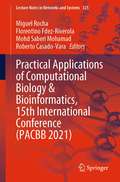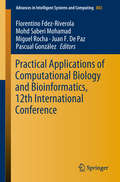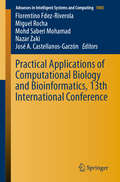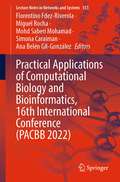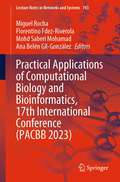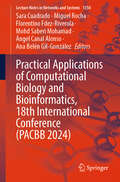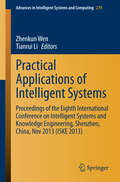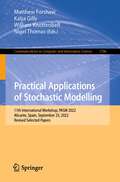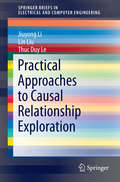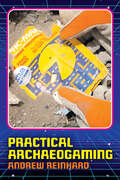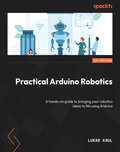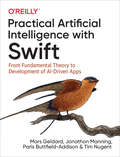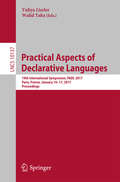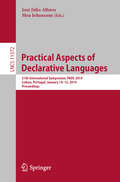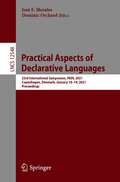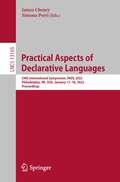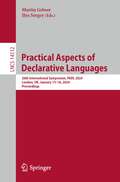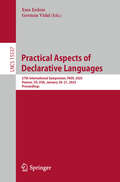- Table View
- List View
Practical Applications of Computational Biology & Bioinformatics, 15th International Conference (Lecture Notes in Networks and Systems #325)
by Florentino Fdez-Riverola Mohd Saberi Mohamad Miguel Rocha Roberto Casado-VaraThis book features novel research papers spanning many different subfields in bioinformatics and computational biology, presenting the latest research on the practical applications to promote fruitful interactions between young researchers in different areas related to the field. Clearly, biology is increasingly becoming a science of information, requiring tools from the computational sciences. To address these challenges, we have seen the emergence of a new generation of interdisciplinary scientists with a strong background in the biological and computational sciences. PACBB'21 expects to contribute to this effort by encouraging a successful collaboration of researchers in different areas related to bioinformatics. The PACBB'21 technical program included 17 papers covering many different subfields in bioinformatics and computational biology. Therefore, this conference, held in Salamanca (Spain), definitely promotes the collaboration of scientists from different research groups and with different backgrounds (computer scientists, mathematicians, biologists) to reach breakthrough solutions for these challenges.
Practical Applications of Computational Biology and Bioinformatics, 12th International Conference (Advances In Intelligent Systems and Computing #803)
by Florentino Fdez-Riverola Juan F. De Paz Mohd Saberi Mohamad Miguel Rocha Pascual GonzálezThis book introduces the latest international research in the fields of bioinformatics and computational biology. It includes various studies in the area of machine learning in bioinformatics, systems biology, omics data analysis and mining, biomedical applications and sequences, which were selected by an international committee and presented at the 12th International Conference on Practical Applications of Computational Biology & Bioinformatics held in Toledo in June 2018.
Practical Applications of Computational Biology and Bioinformatics, 13th International Conference (Advances in Intelligent Systems and Computing #1005)
by Florentino Fdez-Riverola Mohd Saberi Mohamad Miguel Rocha Nazar Zaki José A. Castellanos-GarzónThis book features 21 papers spanning many different sub-fields in bioinformatics and computational biology, presenting the latest research on the practical applications to promote fruitful interactions between young researchers in different areas related to the field. Next-generation sequencing technologies, together with other emerging and diverse experimental techniques, are evolving rapidly, creating numerous types of omics data. These, in turn, are creating new challenges for the expanding fields of bioinformatics and computational biology, which seek to analyse, process, integrate and extract meaningful knowledge from such data. This calls for new algorithms and approaches from fields such as databases, statistics, data mining, machine learning, optimization, computer science, machine learning and artificial intelligence. Clearly, biology is increasingly becoming a science of information, requiring tools from the computational sciences. To address these challenges, we have seen the emergence of a new generation of interdisciplinary scientists with a strong background in the biological and computational sciences. In this context, the interaction of researchers from different scientific areas is, more than ever, vital to boost the research efforts in the field and contribute to the training of the new generation of interdisciplinary scientists.
Practical Applications of Computational Biology and Bioinformatics, 16th International Conference (Lecture Notes in Networks and Systems #553)
by Florentino Fdez-Riverola Mohd Saberi Mohamad Miguel Rocha Simona Caraiman Ana Belén Gil-GonzálezThis book is suitable for researchers and practitioners in biology, medicine and health sciences and bioinformatics. The success of bioinformatics and computational biology in recent years has been driven by research through computational tools and techniques that are essential for data analysis in modern biology and medicine.Systems biology is a related research area that has been replacing the reductionist view that dominated biology research in the last decades, requiring the coordinated efforts of biological researchers with those related to data analysis, mathematical modelling, computer simulation and optimization. The accumulation and exploitation of large-scale databases prompt new computational technology and for research into these issues. In this context, many widely successful computational models and tools used by biologists in these initiatives, such as clustering and classification methods for gene expression data, are based on computer science/ artificial intelligence (CS/AI) techniques. In fact, these methods have been helping in tasks related to knowledge discovery, modelling and optimization tasks, aiming at the development of computational models so that the response of biological complex systems to any perturbation can be predicted.This proceedings of the 16th International Conference on Practical Applications of Computational Biology and Bioinformatics (PACBB), held in L’Aquila (Italy) from July 13 to 15, 2022, contains ten original contributions of authors from many different countries (Bahrain, Canada, France, Italy, Portugal, Saudi Arabia, Spain, and UK) and different subfields in bioinformatics and computational biology.It is also suitable for artificial intelligence researchers interested in exploring applications in biology and health sciences and computational models.
Practical Applications of Computational Biology and Bioinformatics, 17th International Conference (Lecture Notes in Networks and Systems #743)
by Florentino Fdez-Riverola Mohd Saberi Mohamad Miguel Rocha Ana Belén Gil-GonzálezThis book aims to promote the interaction among the scientific community to discuss applications of CS/AI with an interdisciplinary character, exploring the interactions between sub-areas of CS/AI, bioinformatics, chemoinformatics, and systems biology. The success of bioinformatics in recent years has been prompted by research in molecular biology and molecular medicine in several initiatives. This year’s technical program presents both high quality and diversity, with contributions in well-established and evolving areas of research. The PACBB’23 technical program has selected 9 full papers in the main track and, as in past editions, it will be special issues in ranked journals. This symposium is organized by the LASI and Centro Algoritmi of the University of Minho (Portugal). The authors would like to thank all the contributing authors, the members of the program committee, national associations (AEPIA, APPIA), and the sponsors (AIR Institute).
Practical Applications of Computational Biology and Bioinformatics, 18th International Conference (Lecture Notes in Networks and Systems #1350)
by Florentino Fdez-Riverola Mohd Saberi Mohamad Miguel Rocha Sara Cuadrado Ana Belén Gil-González Ángel Canal AlonsoThis book aims to promote the interaction among the scientific community to discuss applications of CS/AI with an interdisciplinary character, exploring the interactions between sub-areas of CS/AI, Bioinformatics, Chemoinformatics and Systems Biology. The success of Bioinformatics in recent years has been prompted by research in Molecular Biology and Molecular Medicine in several initiatives. This year’s technical program presents both high quality and diversity, with contributions in well-established and evolving areas of research. The PACBB’24 technical program has selected 22 full papers in the main track and, as in past editions, it will be special issues in ranked journals. This symposium is organized by the BISITE Research Group of the University of Salamanca (Spain). The author would like to thank all the contributing authors, the members of the Program Committee, National Associations (AEPIA, APPIA), and the sponsors (AIR Institute).
Practical Applications of Intelligent Systems
by Tianrui Li Zhenkun Wen"Practical Applications of Intelligent Systems" presents selected papers from the 2013 International Conference on Intelligent Systems and Knowledge Engineering (ISKE2013). The aim of this conference is to bring together experts from different expertise areas to discuss the state-of-the-art in Intelligent Systems and Knowledge Engineering, and to present new research results and perspectives on future development. The topics in this volume include, but are not limited to: Intelligent Game, Intelligent Multimedia, Business Intelligence, Intelligent Bioinformatics Systems, Intelligent Healthcare Systems, User Interfaces and Human Computer Interaction, Knowledge-based Software Engineering, Social Issues of Knowledge Engineering, etc. The proceedings are benefit for both researchers and practitioners who want to learn more about the current practice, experience and promising new ideas in the broad area of intelligent systems and knowledge engineering. Dr. Zhenkun Wen is a Professor at the College of Computer and Software Engineering, Shenzhen University, China. Dr. Tianrui Li is a Professor at the School of Information Science and Technology, Southwest Jiaotong University, Xi'an, China.
Practical Applications of Stochastic Modelling: 11th International Workshop, PASM 2022, Alicante, Spain, September 23, 2022, Revised Selected Papers (Communications in Computer and Information Science #1786)
by Nigel Thomas Matthew Forshaw William Knottenbelt Katja GillyThis book constitutes the referred proceedings of the 11th International Workshop on Practical Applications of Stochastic Modelling, PASM 2022, was held in Alicante, Spain, in September 2022.The 7 full papers presented in this volume were carefully reviewed and selected from 9 submissions. The papers demonstrate a diverse set of applications and approaches of stochastic modelling.
Practical Approaches to Causal Relationship Exploration
by Jiuyong Li Lin Liu Thuc Duy LeThis brief presents four practical methods to effectively explore causal relationships, which are often used for explanation, prediction and decision making in medicine, epidemiology, biology, economics, physics and social sciences. The first two methods apply conditional independence tests for causal discovery. The last two methods employ association rule mining for efficient causal hypothesis generation, and a partial association test and retrospective cohort study for validating the hypotheses. All four methods are innovative and effective in identifying potential causal relationships around a given target, and each has its own strength and weakness. For each method, a software tool is provided along with examples demonstrating its use. Practical Approaches to Causal Relationship Exploration is designed for researchers and practitioners working in the areas of artificial intelligence, machine learning, data mining, and biomedical research. The material also benefits advanced students interested in causal relationship discovery.
Practical Archaeogaming
by Andrew ReinhardAs a sequel to Archaeogaming: an Introduction to Archaeology in and of Video Games, the author focuses on the practical and applied side of the discipline, collecting recent digital fieldwork together in one place for the first time to share new methods in treating interactive digital built environments as sites for archaeological investigation. Fully executed examples of practical and applied archaeogaming include the necessity of a rapid archaeology of digital built environments, the creation of a Harris matrix for software stratigraphy, the ethnographic work behind a human civilization trapped in an unstable digital landscape, how to conduct photogrammetry and GIS mapping in procedurally generated space, and how to transform digital artifacts into printed three-dimensional objects. Additionally, the results of the 2014 Atari excavation in Alamogordo, New Mexico are summarized for the first time.
Practical Arduino Engineering: End to End Development with the Arduino, Fusion 360, 3D Printing, and Eagle
by Harold TimmisImplement Arduino-based designs in your project, and build, debug, and extend it using a solid engineering approach. This second edition is expanded to provide a better understanding of the engineering process and what it means to be an end-to-end developer. You’ll start out by reviewing basic engineering procedures, from the fundamental requirements and preliminary design to prototyping and testing. You’ll then apply those principles to single devices like LCDs, potentiometers and GPS modules, and move on to the integration of several modules into a larger project, a sub-autonomous robot. This robot will include devices such as GPS, Bluetooth, an OLED screen, an accelerometer, humidity and temp sensor, motor drivers, and ultrasonic sensor. This version goes on to cover how to create 3D models with Fusion360, make your own PCBs using Eagle, and use and maintain a 3D printer. Each and every chapter exemplifies this process and demonstrates how you can profit from the implementation of solid engineering principles—regardless of whether you just play in your basement or you want to publicize and sell your devices. With Practical Adruino Engineering you’ll be able to review and improve this process, and even extend its scope. What You’ll Learn ● Set up the Arduino software landscape and project for testing ● Review the process of hardware engineering as applicable to Arduino projects ● Create 3D models for 3D printing using Fusion360 in a robot chassis project ● Make PCBs using Eagle and incorporate it into a sensor station shield project ● Use and maintain a 3D printer with your own project ● Create Arduino shields in Eagle ● Debug Arduino projects of varying complexities via LabVIEW ● Use a special Arduino board for Bluetooth to control domestic and mobile Arduino projects Who This Book Is For Primarily aimed at intermediate engineers or engineering students. However, this book is also great for beginners and any maker who wants to expand their abilities in a single book.
Practical Arduino Robotics: A hands-on guide to bringing your robotics ideas to life using Arduino
by Lukas KaulBuild your hardware, electronics, and programming skills, and use them to realize your advanced robotics projects with this powerful platformPurchase of the print or Kindle book includes a free PDF eBookKey FeaturesBecome an expert in selecting sensors, motors, and Arduino boards for any robotics projectDiscover how to write effective and reusable code for your Arduino robotics projectsLearn to build a camera-based line follower and a self-balancing telepresence robot on your ownBook DescriptionEvery robot needs a “brain,” and the Arduino platform provides an incredibly accessible way to bring your Arduino robot to life. Anyone can easily learn to build and program their own robots with Arduino for hobby and commercial uses, making Arduino-based robots the popular choice for school projects, college courses, and the rapid prototyping of industrial applications!Practical Arduino Robotics is a comprehensive guide that equips you with the necessary skills and techniques that can be applied to various projects and applications, from automating repetitive tasks in a laboratory to building engaging mobile robots.Building on basic knowledge of programming and electronics, this book teaches you how to choose the right components, such as Arduino boards, sensors, and motors, and write effective code for your robotics project, including the use of advanced third-party Arduino libraries and interfaces, such as Analog, SPI, I2C, PWM, and UART. You'll also learn different ways to command your robots wirelessly, such as over Wi-Fi. Finally, with basic to advanced project examples, this book illustrates how to build exciting autonomous robots like a self-balancing telepresence robot.By the end of this book, you'll be able to design and create your own custom robots for a wide variety of applications.What you will learnUnderstand and use the various interfaces of an Arduino boardWrite the code to communicate with your sensors and motorsImplement and tune methods for sensor signal processingUnderstand and implement state machines that control your robotImplement feedback control to create impressive robot capabilitiesIntegrate hardware and software components into a reliable robotic systemTune, debug, and improve Arduino-based robots systematicallyWho this book is forIf you're excited about robotics and want to start creating your own robotics projects from the hardware up, this book is for you. Whether you are an experienced software developer who wants to learn how to build physical robots, a hobbyist looking to elevate your Arduino skills to the next level, or a student with the desire to kick-start your DIY robotics journey, you'll find this book very useful. In order to successfully work with this book, you'll need basic familiarity with electronics, Arduino boards and the core concepts of computer programming.
Practical Arduino Robotics: A hands-on guide to bringing your robotics ideas to life using Arduino
by Lukas KaulBuild your hardware, electronics, and programming skills, and use them to realize your advanced robotics projects with this powerful platform Purchase of the print or Kindle book includes a free PDF eBookKey FeaturesBecome an expert in selecting sensors, motors, and Arduino boards for any robotics projectDiscover how to write effective and reusable code for your Arduino robotics projectsLearn to build a camera-based line follower and a self-balancing telepresence robot on your ownBook DescriptionEvery robot needs a “brain,” and the Arduino platform provides an incredibly accessible way to bring your Arduino robot to life. Anyone can easily learn to build and program their own robots with Arduino for hobby and commercial uses, making Arduino-based robots the popular choice for school projects, college courses, and the rapid prototyping of industrial applications! Practical Arduino Robotics is a comprehensive guide that equips you with the necessary skills and techniques that can be applied to various projects and applications, from automating repetitive tasks in a laboratory to building engaging mobile robots. Building on basic knowledge of programming and electronics, this book teaches you how to choose the right components, such as Arduino boards, sensors, and motors, and write effective code for your robotics project, including the use of advanced third-party Arduino libraries and interfaces, such as Analog, SPI, I2C, PWM, and UART. You'll also learn different ways to command your robots wirelessly, such as over Wi-Fi. Finally, with basic to advanced project examples, this book illustrates how to build exciting autonomous robots like a self-balancing telepresence robot. By the end of this book, you'll be able to design and create your own custom robots for a wide variety of applications.What you will learnUnderstand and use the various interfaces of an Arduino boardWrite the code to communicate with your sensors and motorsImplement and tune methods for sensor signal processingUnderstand and implement state machines that control your robotImplement feedback control to create impressive robot capabilitiesIntegrate hardware and software components into a reliable robotic systemTune, debug, and improve Arduino-based robots systematicallyWho this book is forIf you’re excited about robotics and want to start creating your own robotics projects from the hardware up, this book is for you. Whether you are an experienced software developer who wants to learn how to build physical robots, a hobbyist looking to elevate your Arduino skills to the next level, or a student with the desire to kick-start your DIY robotics journey, you’ll find this book very useful. In order to successfully work with this book, you’ll need basic familiarity with electronics, Arduino boards and the core concepts of computer programming.
Practical Artificial Intelligence for Internet of Medical Things: Emerging Trends, Issues, and Challenges (Advances in Smart Healthcare Technologies)
by Chinmay Chakraborty Ben Othman Soufiene Faris A. AlmalkiThis book covers the fundamentals, applications, algorithms, protocols, emerging trends, problems, and research findings in the field of AI and IoT in smart healthcare. It includes case studies, implementation and management of smart healthcare systems using AI. Chapters focus on AI applications in Internet of Healthcare Things, provide working examples on how different types of healthcare data can be used to develop models and predict diseases using machine learning and AI, with the real-world examples. This book is aimed at Researchers and graduate students in Computer Engineering, Artificial Intelligence and Machine Learning, Biomedical Engineering, and Bioinformatics. Features: Focus on the Internet of Healthcare Things and innovative solutions developed for use in the application of healthcare services Discusses artificial intelligence applications, experiments, core concepts, and cutting-edge themes Demonstrates new approaches to analyzing medical data and identifying ailments using AI to improve overall quality of life Introduces fundamental concepts for designing the Internet of Healthcare Things solutions Includes pertinent case studies and applications This book is aimed at researchers and graduate students in Computer Engineering, Artificial Intelligence and Machine Learning, Biomedical Engineering, and Bioinformatics.
Practical Artificial Intelligence with Swift: From Fundamental Theory to Development of AI-Driven Apps
by Paris Buttfield-Addison Jonathon Manning Tim Nugent Mars GeldardCreate and implement AI-based features in your Swift apps for iOS, macOS, tvOS, and watchOS. With this practical book, programmers and developers of all kinds will find a one-stop shop for AI and machine learning with Swift. Taking a task-based approach, you’ll learn how to build features that use powerful AI features to identify images, make predictions, generate content, recommend things, and more.AI is increasingly essential for every developer—and you don’t need to be a data scientist or mathematician to take advantage of it in your apps. Explore Swift-based AI and ML techniques for building applications. Learn where and how AI-driven features make sense. Inspect tools such as Apple’s Python-powered Turi Create and Google’s Swift for TensorFlow to train and build models.I: Fundamentals and Tools—Learn AI basics, our task-based approach, and discover how to build or find a dataset.II: Task Based AI—Build vision, audio, text, motion, and augmentation-related features; learn how to convert preexisting models.III: Beyond—Discover the theory behind task-based practice, explore AI and ML methods, and learn how you can build it all from scratch... if you want to
Practical Artificial Intelligence: Machine Learning, Bots, and Agent Solutions Using C#
by Arnaldo Pérez CastañoDiscover how all levels Artificial Intelligence (AI) can be present in the most unimaginable scenarios of ordinary lives. This book explores subjects such as neural networks, agents, multi agent systems, supervised learning, and unsupervised learning. These and other topics will be addressed with real world examples, so you can learn fundamental concepts with AI solutions and apply them to your own projects.People tend to talk about AI as something mystical and unrelated to their ordinary life. Practical Artificial Intelligence provides simple explanations and hands on instructions. Rather than focusing on theory and overly scientific language, this book will enable practitioners of all levels to not only learn about AI but implement its practical uses.What You’ll LearnUnderstand agents and multi agents and how they are incorporatedRelate machine learning to real-world problems and see what it means to youApply supervised and unsupervised learning techniques and methods in the real worldImplement reinforcement learning, game programming, simulation, and neural networksWho This Book Is ForComputer science students, professionals, and hobbyists interested in AI and its applications.
Practical Aspects of Declarative Languages
by Marco Gavanelli John ReppyThis book constitutes the refereed proceedings of the18th International Symposium on Practical Aspects of Declarative Languages,PADL 2016, held in St. Petersburg, FL, USA, in January 2016. The 11 revised papers presented were carefully reviewedand selected from 17 initial submissions for inclusion in the book. PADL is a forumfor researchers and practitioners to present original work emphasizing novelapplications and implementation techniques for all forms of declarativeconcepts, including, functional, logic, constraints, etc.
Practical Aspects of Declarative Languages
by Yuliya Lierler Walid TahaThis book constitutes the proceedings of the 19th International Symposium on Practical Aspects of Declarative Languages, PADL 2017, held in Paris, France, in January 2017 and collocated with the ACM SIGPLAN Symposium on Principles of Programming Languages. The 14 papers presented in this volume were carefully reviewed and selected from 27 submissions. They deal with novel applications and implementation techniques for all forms of declarative languages, including but not limited to logic, constraint, and functional languages.
Practical Aspects of Declarative Languages: 21th International Symposium, PADL 2019, Lisbon, Portugal, January 14-15, 2019, Proceedings (Lecture Notes in Computer Science #11372)
by Moa Johansson José Júlio AlferesThis book constitutes the refereed proceedings of the 21st International Conference on Practical Aspects of Declarative Languages, PADL 2019, held in Lisbon, Portugal, in January 2019. The 14 revised full papers were carefully reviewed and selected from 35 submissions. The papers present original work emphasizing novel applications and implementation techniques for all forms of declarative concepts, including logic, constraint, and functional languages.
Practical Aspects of Declarative Languages: 22nd International Symposium, PADL 2020, New Orleans, LA, USA, January 20–21, 2020, Proceedings (Lecture Notes in Computer Science #12007)
by Yanhong Annie Liu Ekaterina KomendantskayaThis book constitutes the refereed proceedings of the 22nd International Symposium on Practical Aspects of Declarative Languages, PADL 2020, held in New Orleans, USA, in January 2020. The 10 full and 4 short papers were carefully reviewed and selected from 24 submissions. The papers present original work emphasizing novel applications and implementation techniques for all forms of declarative concepts, including programming with sets, functions, logic, and constraints. The papers are organized in the following topical headings: logical engines and applications; answer set programming systems; memory and real-time in functional programming; reasoning and efficient implementation; and small languages and implementation.
Practical Aspects of Declarative Languages: 23rd International Symposium, PADL 2021, Copenhagen, Denmark, January 18-19, 2021, Proceedings (Lecture Notes in Computer Science #12548)
by José F. Morales Dominic OrchardThis book constitutes the refereed proceedings of the 23rd International Symposium on Practical Aspects of Declarative Languages, PADL 2021, held in Copenhagen, Denmark, in January 2021. The 10 full papers were carefully reviewed and selected from 21 submissions. The papers present original work emphasizing novel applications and implementation techniques for all forms of declarative concepts, including programming with sets, functions, logic, and constraints. The papers are organized in the following topical headings: Foundations and Programming Concepts; Applications of Declarative Languages, and Declarative Approaches to Testing and Debugging. Due to the Corona pandemic PADL 2021 was held as a virtual event.
Practical Aspects of Declarative Languages: 24th International Symposium, PADL 2022, Philadelphia, PA, USA, January 17–18, 2022, Proceedings (Lecture Notes in Computer Science #13165)
by James Cheney Simona PerriThis book constitutes the refereed proceedings of the 24th International Conference on Practical Aspects of Declarative Languages, PADL 2022, held in Philadelphia, PA, USA, during January 17-18, 2022. The 9 full papers and 4 short papers included in this book were carefully reviewed and selected from 22 submissions. They were organized in topical sections as follows: answer set programming; functional programming; languages, methods and tools; and declarative solutions.
Practical Aspects of Declarative Languages: 26th International Symposium, PADL 2024, London, UK, January 15–16, 2024, Proceedings (Lecture Notes in Computer Science #14512)
by Martin Gebser Ilya SergeyThis book constitutes the refereed proceedings of the 26th International Conference on Practical Aspects of Declarative Languages, PADL 2024, held in London, UK, during January 17–19, 2024.The 13 full papers included in this book were carefully reviewed and selected from 25 submissions. The accepted papers span a range of topics related to functional and logic programming, including reactive programming, hardware implementations, implementation of marketplaces, query languages, and applications of declarative programming techniques to artificial intelligence and machine learning.
Practical Aspects of Declarative Languages: 27th International Symposium, PADL 2025, Denver, CO, USA, January 20–21, 2025, Proceedings (Lecture Notes in Computer Science #15537)
by Esra Erdem Germán VidalThis book constitutes the refereed proceedings of the 27th International Symposium on Practical Aspects of Declarative Languages, PADL 2025, held in Denver, CO, USA, during January 20–21, 2025. The 15 full papers included in this book were carefully reviewed and selected from 26 submissions. The accepted papers span a range of topics related to functional and logic programming, including some novel applications of Answer Set Programming, language extensions, runtime monitoring, program transformations, type-checking, and applications of declarative programming techniques to artificial intelligence and machine learning, among others.
Practical Astronomy with your Calculator or Spreadsheet
by Peter Duffett-Smith Jonathan ZwartNow in its fourth edition, this highly regarded book is ideal for those who wish to solve a variety of practical and recreational problems in astronomy using a scientific calculator or spreadsheet. Updated and extended, this new edition shows you how to use spreadsheets to predict, with greater accuracy, solar and lunar eclipses, the positions of the planets, and the times of sunrise and sunset. Suitable for worldwide use, this handbook covers orbits, transformations and general celestial phenomena, and is essential for anyone wanting to make astronomical calculations for themselves. With clear, easy-to-follow instructions for use with a pocket calculator, shown alongside worked examples, it can be enjoyed by anyone interested in astronomy, and will be a useful tool for software writers and students studying introductory astronomy. High-precision spreadsheet methods for greater accuracy are available at www. cambridge. org/practicalastronomy.
